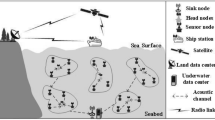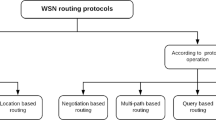Abstract
For wireless sensor networks, it is crucial to determine the geographic area where events occur, and the localization of unknown nodes has become one of the challenging problems today. The Distance Vector-Hop (DV-Hop) algorithm has gained attention as a popular localization method for wireless sensor networks. However, it faces limitations in irregular areas and regions with unevenly distributed nodes, as the accuracy of hop distance calculation is heavily impacted by network topology. For irregular networks under the influence of obstacles and voids, the proposed algorithm optimizes the hop spacing of reliable beacon nodes within a limited number of hops and designs an enhanced sand cat optimization (ESCO) algorithm to solve the localization problem. In the simulation tests, benchmark functions with different characteristics are used to verify the convergence speed and accuracy of the ESCO algorithm. In addition, the proposed algorithm based on reliable node optimization and enhanced sand cat optimization (RESCO DV-Hop) is also applied to the node localization process and compared with five recent algorithms. The experimental results show that the proposed algorithm achieves the best localization accuracy under C-, H-, and X-type network structures. More precisely, the localization accuracy is improved by around 58, 53, and 43%, respectively, compared with the original algorithm, in the best case.




















Similar content being viewed by others
Availability of data and materials
The datasets generated during and/or analyzed during the current study are available from the corresponding author on reasonable request.
References
Tu Q, Zhao Y, Liu X (2022) Recovery schemes of Hop Count Matrix via topology inference and applications in range-free localization. Exp Syst Appl 200:116906. https://doi.org/10.1016/j.eswa.2022.116906
Souissi I, Azzouna NB, Said LB (2019) A multi-level study of information trust models in WSN-assisted IoT. Comput Netw 151:12–30. https://doi.org/10.1016/j.comnet.2019.01.010
Cesar TQZ, Leal PAM, Branquinho OC, Miranda FAM (2021) Wireless sensor network to identify the reduction of meteorological gradients in greenhouse in subtropical conditions. J Agric Eng, 52(1). https://doi.org/10.4081/jae.2020.1105
He J, Zhu Z, Wang F, Li J (2019, January). Illumination control of intelligent street lamps based on fuzzy decision. In 2019 International Conference on Intelligent Transportation, Big Data and Smart City (ICITBS) (pp. 513–516). IEEE. https://doi.org/10.1109/ICITBS.2019.00129
Zhang Y, Liu M (2020) Adaptive directed evolved NSGA2 based node placement optimization for wireless sensor networks. Wireless Netw 26(5):3539–3552. https://doi.org/10.1007/s11276-020-02279-2
Singh PK, Sharma A (2022) An intelligent WSN-UAV-based IoT framework for precision agriculture application. Comput Electrical Eng 100:107912. https://doi.org/10.1016/j.compeleceng.2022.107912
Kayiram K, Reddy PCS, Sharma A, Lalitha RVS (2021, January). Energy efficient data retrieval in wireless sensor networks for disaster monitoring applications. In 2021 International Conference on Sustainable Energy and Future Electric Transportation (SEFET) (pp. 1–7), IEEE. https://doi.org/10.1109/SeFet48154.2021.9375679
Zhang QS (2023) Environment pollution analysis on smart cities using wireless sensor networks. Strategic Plan Energy Environ, pp 239–262. https://doi.org/10.13052/spee1048-5236.42112
Meng Y, Zhi Q, Dong M, Zhang W (2021) A node localization algorithm for wireless sensor networks based on virtual partition and distance correction. Information 12(8):330. https://doi.org/10.3390/info12080330
Kagi S, Mathapati BS (2021, January). Localization in wireless sensor networks: a compact review on state-of-the-art models. In: 2021 6th International Conference on Inventive Computation Technologies (ICICT) (pp. 5–12). IEEE. https://doi.org/10.1109/ICICT50816.2021.9358793
Chen T, Hou S, Sun L (2022) An enhanced DV-Hop positioning scheme based on spring model and reliable beacon node set. Comput Netw 209:108926. https://doi.org/10.1016/j.comnet.2022.108926
Du J, Yuan C, Yue M, Ma T (2022) A novel localization algorithm based on RSSI and multilateration for indoor environments. Electronics 11(2):289. https://doi.org/10.3390/electronics11020289
Dai Z, Wang G, Chen H (2021) Sensor selection for TDOA-based source localization using angle and range information. IEEE Trans Aerospace Electronic Syst 57(4):2597–2604. https://doi.org/10.1109/TAES.2021.3061826
Yang G, Yan Y, Wang H, Shen X (2022) Improved robust TOA-based source localization with individual constraint of sensor location uncertainty. Signal Process 196:108504. https://doi.org/10.1016/j.sigpro.2022.108504
Wang L, Su D, Liu M, Du X (2022) Modified zeroing neurodynamics models for range-based WSN localization from AOA and TDOA measurements. IEEE Sens J 22(13):13716–13726. https://doi.org/10.1109/JSEN.2022.3177409
Hu P, Zhang B (2021, April). Research on centroid localization algorithm in wireless sensor networks. In: Journal of Physics: Conference Series (vol 1883, No 1, p 012026). IOP Publishing. https://doi.org/10.1088/1742-6596/1883/1/012026
Yuan Y, Huo L, Wang Z, Hogrefe D (2018) Secure APIT localization scheme against sybil attacks in distributed wireless sensor networks. IEEE Access 6:27629–27636. https://doi.org/10.1109/ACCESS.2018.2836898
Song PC, Chu SC, Pan JS, Wu TY (2022) An adaptive stochastic central force optimisation algorithm for node localisation in wireless sensor networks. Int J Ad Hoc Ubiquitous Comput 39(1–2):1–19. https://doi.org/10.1504/IJAHUC.2022.120940
Kaur A, Gupta GP, Mittal S (2022) Comparative study of the different variants of the dv-hop based node localization algorithms for wireless sensor networks. Wireless Personal Commun 123(2):1625–1667. https://doi.org/10.1007/s11277-021-09206-4
Huang X (2020) Multi-node topology location model of smart city based on internet of things. Comput Commun 152:282–295. https://doi.org/10.1016/j.comcom.2020.01.052
Ouyang A, Lu Y, Liu Y, Wu M, Peng X (2021) An improved adaptive genetic algorithm based on DV-Hop for locating nodes in wireless sensor networks. Neurocomputing 458:500–510. https://doi.org/10.1016/j.neucom.2020.04.156
Kanwar V, Kumar A (2021) DV-Hop localization methods for displaced sensor nodes in wireless sensor network using PSO. Wireless Netw 27(1):91–102. https://doi.org/10.1007/s11276-020-02446-5
Song L, Zhao L, Ye J (2019) DV-hop node location algorithm based on GSO in wireless sensor networks. J Sens 2019. https://doi.org/10.1155/2019/2986954
Singh P, Mittal N, Singh P (2022) A novel hybrid range-free approach to locate sensor nodes in 3D WSN using GWO-FA algorithm. Telecommun Syst, pp 1–21. https://doi.org/10.1007/s11235-022-00888-0
Mohanta TK, Das DK (2022) Advanced localization algorithm for wireless sensor networks using fractional order class topper optimization. J Supercomput 78(8):10405–10433. https://doi.org/10.1007/s11227-021-04278-2
Wu G, Wang S, Wang B, Dong Y, Yan S (2012) A novel range-free localization based on regulated neighborhood distance for wireless ad hoc and sensor networks. Comput Netw 56(16):3581–3593. https://doi.org/10.1016/j.comnet.2012.07.007
Cui L, Xu C, Li G, Ming Z, Feng Y, Lu N (2018) A high accurate localization algorithm with DV-Hop and differential evolution for wireless sensor network. Appl Soft Comput 68:39–52. https://doi.org/10.1016/j.asoc.2018.03.036
Kaur A, Kumar P, Gupta GP (2018) Nature inspired algorithm-based improved variants of DV-Hop algorithm for randomly deployed 2D and 3D wireless sensor networks. Wireless Personal Commun 101(1):567–582. https://doi.org/10.1007/s11277-018-5704-7
Cheikhrouhou O, M. Bhatti, G, Alroobaea R (2018) A hybrid DV-hop algorithm using RSSI for localization in large-scale wireless sensor networks. Sensors 18(5):1469. https://doi.org/10.3390/s18051469
Shi Q, Xu Q, Zhang J (2019) An improved DV-Hop scheme based on path matching and particle swarm optimization algorithm. Wireless Personal Commun 104(4):1301–1320. https://doi.org/10.1007/s11277-018-6084-8
Liu J, Liu M, Du X, Stanimirovi PS, Jin L (2022) An improved DV-Hop algorithm for wireless sensor networks based on neural dynamics. Neurocomputing 491:172–185. https://doi.org/10.1016/j.neucom.2022.03.050
Chen T, Sun L, Wang Z, Wang Y, Zhao Z, Zhao P (2021) An enhanced nonlinear iterative localization algorithm for DV_Hop with uniform calculation criterion. Ad Hoc Netw 111:102327. https://doi.org/10.1016/j.adhoc.2020.102327
Hadir A, Regragui Y, Garcia NM (2021) Accurate range-free localization algorithms based on PSO for wireless sensor networks. IEEE Access 9:149906–149924. https://doi.org/10.1109/ACCESS.2021.3123360
Ou X, Wu M, Pu Y, Tu B, Zhang G, Xu Z (2022) Cuckoo search algorithm with fuzzy logic and Gauss-Cauchy for minimizing localization error of WSN. Appl Soft Comput 125:109211. https://doi.org/10.1016/j.asoc.2022.109211
Yu XW, Huang LP, Liu Y, Zhang K, Li P, Li Y (2022) WSN node location based on beetle antennae search to improve the gray wolf algorithm. Wireless Netw 28(2):539–549. https://doi.org/10.1007/s11276-021-02875-w
Seyyedabbasi A, Kiani F (2022) Sand Cat swarm optimization: a nature-inspired algorithm to solve global optimization problems. Eng Comput, pp 1–25. https://doi.org/10.1007/s00366-022-01604-x
Wang P, Huang J, Cui Z, Xie L, Chen J (2020) A Gaussian error correction multi-objective positioning model with NSGA-II. Concurrency Comput Practice Exp 32(5):e5464. https://doi.org/10.1002/cpe.5464
Funding
The authors declare that no funds, grants, or other support was received during the preparation of this manuscript.
Author information
Authors and Affiliations
Contributions
HS and MT conceived the entire study and participated in the design and drafting of the complete manuscript.
Corresponding author
Ethics declarations
Conflict of interest
The authors declare that they have no conflicts of interest to this work.
Ethics approval statement
This article does not contain any research involving humans or animals, and ethical approval does not apply to this article.
Additional information
Publisher's Note
Springer Nature remains neutral with regard to jurisdictional claims in published maps and institutional affiliations.
Rights and permissions
Springer Nature or its licensor (e.g. a society or other partner) holds exclusive rights to this article under a publishing agreement with the author(s) or other rightsholder(s); author self-archiving of the accepted manuscript version of this article is solely governed by the terms of such publishing agreement and applicable law.
About this article
Cite this article
Sun, H., Tian, M. Improved range-free localization algorithm based on reliable node optimization and enhanced sand cat optimization algorithm. J Supercomput 79, 20289–20323 (2023). https://doi.org/10.1007/s11227-023-05436-4
Accepted:
Published:
Issue Date:
DOI: https://doi.org/10.1007/s11227-023-05436-4




